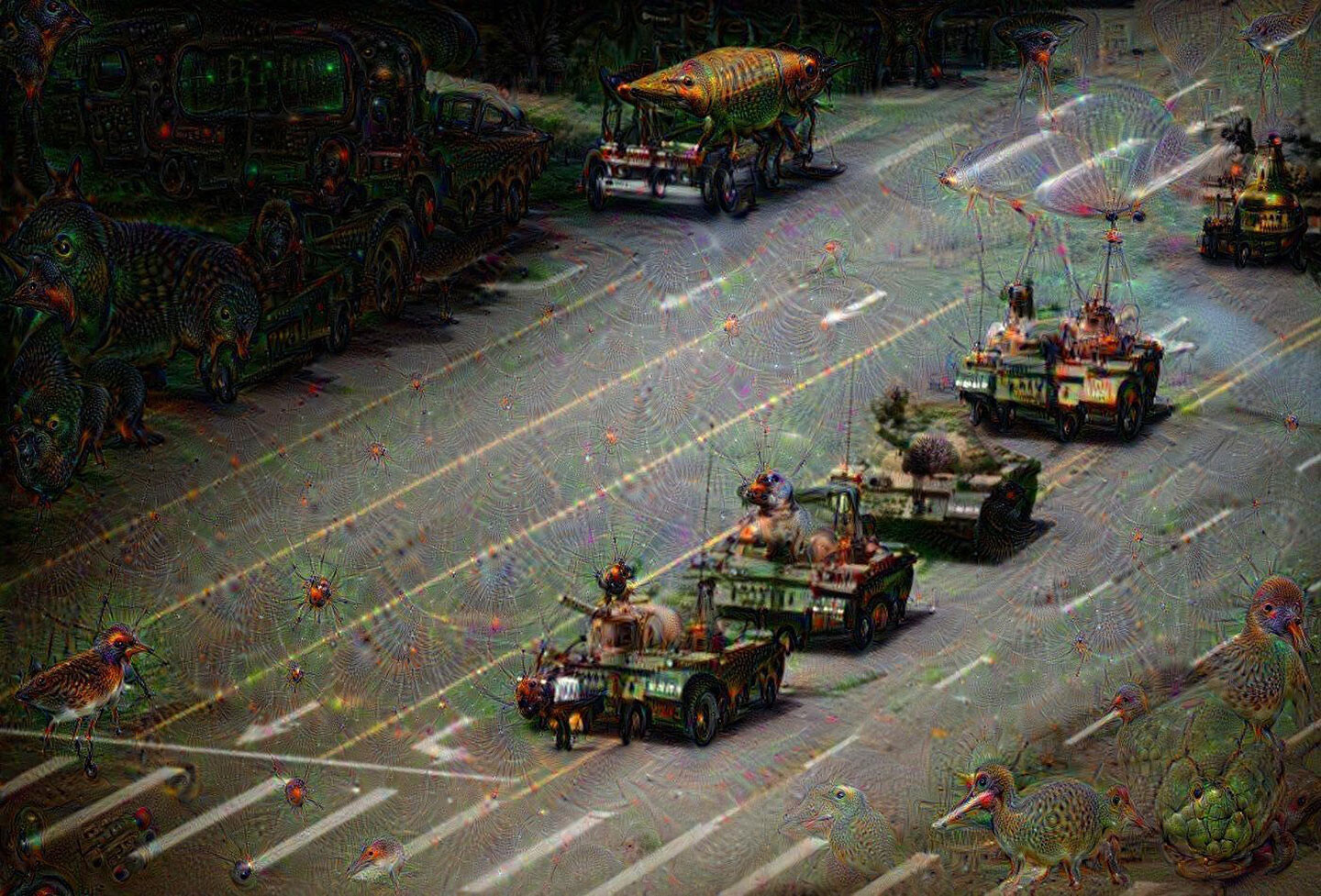Spectral Politics and a New Money-Form: Global Post-Fordism as CGI
Computational capital has not ended racial capitalism; it is an intensification of a viral modality of accumulation that increasingly binds “civilization” to racializing violence. Computational capital has not dismantled racial capitalism’s vectors of oppression, operational along the exacerbated fracture lines of social difference that include race, gender, sexuality, religion, nation, and class; it has built itself and its machines out of those capitalized and technologized social differentiations. In short, computational capital is the condition of possibility of the current conjuncture of hierarchical society that Silvia Federici aptly names “The System of Global Apartheid.” With intensified violence, the lived categories of race, gender, sexuality, nation, religion, disability, and others are all mobilized, calibrated, and recalibrated across micro and macro domains, as logistics of extraction and control.


After a UN antidiscrimination campaign highlighted the most-used search terms for women on Google, an Australian campaign focuses on the top queries relating to black men.
Consider the role of digitization and computation in reorganizing sign function and semiosis. In the twentieth century quantification extends itself through the calculus of the image (film, television) and in the twenty first morphs again into social media, where “communication” itself becomes a value-extractive process.1 The triumph of the touchscreen is the explosive advance of the screen interface, further transforming semiosis into a deterritorialized, distributed factory, advancing the thoroughgoing quantification of the life-world that began with the medium of money and the plantocratic and industrial institutionalization of wage labor. Communication-as-means-of-expression, organization, aspiration, and liberation is captured in advance, by means of digitization on platforms that operate as fixed capital, and is converted in real time to communication-as-means-of-domination-and-control. In financialized informatic space, you can send your message, but at a price—and it is not only you that will pay. Taken as a whole, the communications infrastructure is a medium of accumulation for the few and of dispossession for the many.
The celebrity and the celebrity leader, a condensation and mobilization of massive attention, is one type of output of this system, and masses of people dispossessed of both the proceeds of their creativity and of the traditional commons is another. Such capture and deployment of attentional capital by means of the celebrity-form marks a significant shift in the dominant mode of production while specifying a relation between attention economies, coloniality, and cult. The mediological model of ambient computation functioning as a calculus of value has become paradigmatic for industries subject to derivative pricing, wherein nearly all activities are subject to dynamic pricing and speculation. From the poor Indian farmer to the self-styled Instagram model, everyone manages their assets in an semio-economic zone characterized on the content-provider side by precarity, volatility, and risk. Care and attention are bundled and recut, and their surplus value moves up the hierarchy. The algorithmic parsing of Facebook “likes” by the company Cambridge Analytica, which allowed the Trump campaign to send surgically tailored messages to precisely profiled target audiences in the US, is one affordance alienated expression makes available to the wealthy. Wealth is another.
Global semiosis has been systemically captured, extracted, and abstracted by financialized computational media. Planet-wide hierarchized sociality places attention on the market, incentivizing fractal accumulation through generalized algorithmic expropriation. The result is what I call computational capital. Considered as a process, computational capital includes both the logistics of self-aggrandizement and visibility, as well as those of disavowal and invisibility. In the same way that the process of industrial capital included both the celebration of work, and, in the moment of crisis, its refusal—in the form of a strike or a lockout—so, too, does the cycle of computational capital include both the celebration of representation and its refusal. And much more. As Allen Feldman shows regarding the production of “the terrorist” at Guantanamo, subjects are not just disappeared but blurred, ontologies are both erased and reinscribed from without.2 Such practices are perceptible symptoms of the intensive vectors of appropriation and dispossession that characterize contemporary sociality in the world-media system. However, the consequences of feeding human emotion and cognition into binary machines responsible for manipulating and leveraging these feelings and ideas in the service of accumulation go well beyond the screen. If fractal celebrity is really just a subgenre of fractal fascism, it is because the crises of the “old capitals,” especially merchant and industrial capitals—think of the proverbial “downtown destroyed by Walmart” or the “devastated factory town”—produce a reactionary politics every bit as sensational as the follies of the beautiful class. Computational capital can accumulate across crises of a more traditional political-economic kind by converting crises into attractions, or what Debord called spectacle.
Analogous to the land- and water-based commons that was planet earth, the cognitive-linguistic, the visual-poetic, and the imagination have undergone massive colonial expropriations, following immediately upon their separation and “liberation” from traditional ties to the body, and have entered directly into capitalist servitude. Bernard Stiegler refers to this phenomenon of cognitive collapse and short-termist thinking, organized by what he refers to as mnemotechnologies (technologies of memory that include print, cinema, and computation), as the “proletarianization of the senses.” This follows upon and overlaps with the proletarianization of the masses by the long industrial revolution and the capture and unspeakable violation of designated bodies by the slave trade. These aggressive and oftentimes annihilating encroachments on corporality, the senses, and the linguistic commons, achieved by cybernetic means, are mediological and technical phenomena as much as they are sociopolitical ones. Put another way, the mediological and the technical have been sociopolitical all along—to such an extent that with the level of technical saturation present today, “the political” has been lost.3 The “loss of the political” is an acknowledgement of the subsumption of policies and programs by capitalized financial calculus that chains representation to the process of accumulation. What indeed can “political” mean in a world increasingly characterized by algorithmic governance and platform sovereignty, that is, where capitalist power is increasingly automated, and discursive and affective labor is posited as a mere subroutine of capitalized computational processes—as engines of value creation? What of the political when “politics” has become a subroutine of computational capital and its discourses and actions are a modality of value extraction? It is an old lesson but it still applies (and we can see it from Israel to Burma): if subalterns use the same media and therefore modes of value extraction as oppressors in their struggles, then politics is simply a war over who will get the spoils of exploitation.
The expropriation of the cognitive-linguistic by capital reduces discursive production—including the discourse of politics—to the subroutine of an abstract machine. This “machine,” though abstract, is nonetheless functional and material—we recognize it as the increasingly ubiquitous, increasingly networked computer or discrete state machine, but we must not see it as mere technology. The universal Turing machine, which when unified posits what I call the World Computer (“the invisible hand” codified as AI), has become the preeminent form of fixed capital. Machinic enslavement, whether to the assembly line, to the “media,” or to the computer, is indeed enslavement by other means, though we must insist that many of the “older” methods of extraordinary servitude stubbornly persist and the pain, like the profit, remains unevenly distributed.


Following a backlash, in August 2017 the popular “FaceApp” removed a series of racially themed filters it had issued. The app had allowed digital blackface, yellowface, brownface, and a Caucasian setting to be added to selfies.
Inequality, now sedimented into institutions and machines as materialized abstractions and designed into apparatuses, operationalizes historically variegated injustice, to produce and reproduce a planetary culture that at bottom is founded upon racism, gender inequality, national and cultural codifications, modern slavery, and a near total dispossession for billions. Machines, too, must be understood as racial formations. Given the data-logical nature of financialized systems underpinning “cultural” expression and iterated in and as machines, it is no surprise that Facebook’s machine-learning algorithm “Deep Face” imaged the minimally recognizable human face as that of a white man.
Converting social life and social history into digital information and digital machines facilitates the as yet un-transcendable program of quantification that runs parallel to social-historical processes of social differentiation for the purpose of accumulation. The social emerges not as an abstract idea, but as a concrete substrate of computation. Sociality is posited then programmed as a series of leveraged accumulation strategies operating above or below or explicitly in and through everyday consciousness. Public faces are forms of data visualization and, circulating as images, are both programs and programmable. Bodies become “necessary media” of machinic digital operations that require from us (us bodies) attention, cognition, neuro-power, virtuosity, and sheer survival. As the auto-enthnography that is critical theory in the West might indicate, the remainders—interiorities and isles of awareness that fall away from informatic throughput—are in large part melancholic, cynical, disaffected, and abject laments.
The rise of actually existing digitality thus appears as inseparable from the development and intensification of capitalism, that is, of media technologies as media of capital, which is also to say as media for the leveraging of agency and representation, such that decisions are made hierarchically and systemically while many aspects of life become almost unrepresentable and thus also unknown and unknowable. The ordinary taxonomies of social history continue to index zones and inflection points of this total and in certain definitive respects totalitarian process of digital enclosure. Our situation is effectively one of platform totalitarianism in which (the social) metabolism itself is captured by a leveraged exchange with capital and our media and machines are not only social relations but racial formations. This leveraged exchange of metabolism for forms of currency at rates set by platform capitalism is managed by ambient and ubiquitous computation, an electro-mechanical network that is composed primarily of fixed capital. The skeins of accumulation by means of informatic uptake lay closely upon body, mind, and time, and what value is extracted are the products of these. Thought and feeling are rendered quantifiable, computable, and indeed programmable. However, it is always a mistake to imagine that the impact of technology flows only in one direction: technical form emerges in a dialectics of domination and struggle. The global, technical evolution in the scale and granularity of the metabolic capture of what was once called labor power and social cooperation—a capture that fragments and cellularizes populations as well as bodies, minds, and neural networks—is not without its emancipatory potentials, as a Benjamin or a Brecht might remind us were they alive today. “The bad new things” are built out of and in response to new forms of struggle, and as Antonio Negri has always emphasized, the innovations of capitalist techné come from below, from the ways that the oppressed outflank domination and persist in living.


A survey machine for customer feedback on the “immigration experience”—as long as the feedback is expressed in the form of smiley or frowny emojis.
Towards a Reclamation of Value
How then to investigate the capture and neutralization of the political domain and its uncountable longings by media-interfaced Computational Capitalism? How to transform and reprogram the failing powers of analysis, sensibility, and action such that they may function beyond the horizon of capitalist control? Four main hypothesis can guide us: 1) Computational Capitalism is an ambient financial calculus of value extraction working through any and all media. 2) Computational Capitalism is a development of Racial Capitalism and is thus also Computational Colonialism: vectors of race, gender, nation, sexuality, and other forms of social difference have been configured by and as strategies of value extraction and, like “structural racism,” have been sedimented into the operating systems and machine architectures of our machines. 3) The specter of revolution is everywhere visible if one knows how to see it. 4) For the first time in history a thoroughgoing revolution is possible that does not replicate the failed strategies of the radical break so tragically characteristic of twentieth-century revolutionary movements, but instead works to decolonize computation by transforming the money-form from within.
I take it as axiomatic that the items telegraphically listed in the previous paragraph have become inseparable. What we thought of simply as computation is in fact computational capital—a supple and adaptive machine-mediated calculus on the social metabolism, one that can be gleaned through a deeper reflection on the notion of convergence. To illustrate aspects of convergence, we note that racialization and nationalization, along with regimes of gender, sexuality, borders, and incarceration, are part and parcel of the overall process of corporeal inscription, codification, and programmatic control endemic to digitization. Niche marketing and profiling are but two of the ways in which our bodies and practices are coded for capitalist and state-capitalist processing. One could add here the attempted subsumption of entire demographics under codifications indexed by “thug” and “terrorist.” Historical codes, including but not limited to race, gender, nation, class, and sexuality, are inscribed on our bodies, read, written, and rewritten by informatic machines. This functionalization of social difference (representational, biometric), to say nothing of the branding and scarring of bodies that is both past and present at so many levels, serves both as a means and a medium of capitalization and value extraction and as a necessary substrate to the development of computation.4 Within and at the scenes of inscription, the code works us and we work the code—again with historically overdetermined statistical variance. This is how it is at both the micro and the macro levels of struggle and organization. IBM’s role in the Holocaust, to give but one example, must also be understood as the Holocaust’s role in IBM and in the development of Hollerith punch cards and computational architectures, including search engines. Sociality and global lifetimes themselves have become the conditions of possibility for what, writ large, is the totalitarian emergence of the World Computer. That is why no existing political discourse can approach this horizon because current concepts and the activities of thought itself are fully circumscribed by it—ideas themselves have become operators (media) fully functionalized by and in the matrix of information.
Understanding the transformation of semiotic process by information functioning as a form of capital, we can take the general formula for capital M-C-M’ (where M is money, C is commodity and, M’ is a greater quantity of money) and rewrite it as M-I-C-I’-M’, where I is image and C is code.5 The commodity as a distributed social relation has, with computation, become both produced and distributed in nonlinear networked operations that, unlike the assembly line, depend upon digital forms of attention, cognition, images, and codes for full valorization. This dependence on transformed conditions of labor germane to the social factory is (now) true even of older forms of production (e.g., automobiles) inasmuch as they are also networked in the world of information, advertising, Instagram, and the like. The valuation of a commodity requires a calculus of the image that modifies code, as does any interaction that transfers rights and value to said commodity (what used to be called sales). Production, circulation, valuation are all mediated by image and code, and that mediation occurs on a global scale. As the Anthropocene and its derivative concepts might testify, little or nothing remains untouched by this process of computational capital that penetrates down to the level of atoms. Here I want to propose further that this formula can be further modified to read M-I-M’, where I is information. To put this modification simply, money becomes more money through the movement of discrete state machines, the motor force of which is ultimately the bios (what was once thought of as the human life-world) struggling to survive its informatic capture. Labor becomes informatic labor and, as I endeavor to show in The Message is Murder, M-I-M’ means less that the commodity is one form of information, and more that the domain of intelligibility known as “information” directly emerges in the footprint of the value-form.6
Data visualization by computational processes screen-interfaced with the bios is a fundamental condition of the current regime of accumulation sometimes called post-Fordism. In generating M’ from M, it also effects what Paolo Virno calls “the communism of capital.” The programmable image as a worksite transforms and colonizes nearly all mental, sensual, and neuronal process while submitting them to interoperable regimes of background monetization. This financialization of everyday life, where everyone is forced to continuously throughput information in order to manage volatility and risk, facilitates a machinic enslavement profoundly enabled by and integrated with inherited forms of oppression. Navigating the matrix of capital-information is not an option, it is a matter of survival.
Somewhere along the way, “consumer society” and “conspicuous consumption” became a semiotic game of survival. In the dominant order, these encodings are among the terms of wealth and power and only those who strive to organize in accord with a different order (or disorder) altogether have more than an inkling that there are better ways to be. We are dealing with the failure of revolutions, the overcoding of bodies and practices, and the absorption of political energy by strategies of accumulation. Computational capital names the integration of discrete state machines with fixed capital and sociality such that Marx’s “vast automaton” has become a global financialized socio-cybernetic system. “Politics” has been operationally reduced to a mere subroutine in the encroachment of this computationally integrated system on planetary life, and as Harney and Moten have pointedly underscored, “politics” and “policy” are today always on the side of the state—and the state is a state of capital.


Photographer Jeff Widener’s record of the Tiananmen Square massacre, 1989, as interpreted by the Google Deepdream algorithm.
Towards a New Money-Form
Whether or not there exists a real possibility of noncapitalist computational communization depends on the following question: Can we write code for the undercommons? We risk this question here.
The long history of commodification, and the quantification that capitalism has gradually imposed on nearly everything over the past seven hundred years, reaches a higher state of complexity in and through digitality. What we now call digital culture (Digital Culture 2 or DC2) is the result of the longue-durée digitization of global life imposed by capital (DC1). Capital, as Nick Dyer-Witheford puts it with electrifying clarity, was always already a computer.7 The systematic, antidemocratic exploitation of life-energy as quantitative capital accumulation (colonialism, slavery, industrialization, imperialism), and the qualitative spectral legacies and insurgent sensibilities of anticapitalist struggles broadly conceived (decolonization, feminist, antiracist, queer, neuro-diverse), are always already situated within a matrix of emerging digital systems. The struggle with digitality so understood implies that many of the terms of historical struggles and newly emergent pleasures of the past seven centuries were organized in large part by the logistics of money as capital—money, it must be underscored, as a medium of racial capitalism and as a medium that extends in and through the informatics of computational capital. Money that is reincarnated as information.
The three classical determinations of money—money as measure, medium, and capital—have been utilized to leverage power and construct the built environment, including the domain of computation, but as screen interfaces intimate, new forms of currency such as likes and other attention metrics have arisen to index screen-mediated value transactions. In addition to measure (price), medium (circulation), and capital (surplus-value extraction), these digital metrics indexing new orders of digital transactions (e.g., likes) are not incidental but forecast a transformation of the money-form adequate to the transformation of labor (which for the early Marx was always sensuous labor) by screen cultures and screen technologies—be that labor manual, immaterial, affective, sensual, cognitive, whatever. In the development of new forms of incentivization and recognition, we can clearly see that money as “general equivalent” and “general form of social wealth” is being reworked in these techno-cultural shifts. Attention is harvested and brokered on platforms such as Google and Facebook (and now by Steemit and Mozilla’s Basic Attention Token); this brokerage is in fact the business of these computational formations, and it is this harvesting of attention, which must be measured, parsed, bundled, and sold, that produces shareholder (and in the latter cases token-holder) value. Bitcoin and Ethereum, and at this point several hundred other crypto-currencies, have further abstracted and formalized schemas for the monetization of sociality; indeed, their market caps are digitized aggregations of semiotic speculations regarding the futurity of their communities. These currency platforms are in fact far more like Google and Facebook than is commonly understood. They are similar in that they encrypt new forms of participation and potentiality in platforms that provide emergent forms of empowerment for their participants and thereby produce economic value. However, rather than serving as a therapeutic medium of entertainment/access (as with TV), or of expression/communication/access (as with Google and Facebook), which in each case siphons profits to third-party owners through the direct financialization of the qualities of attention brought by participants, the participants are stakeholders. Thus many of the new crypto communities enable a cooperative relation to money in all senses of that word.
Nonetheless, as financial media, crypto-currencies may be seen at present as an extremely narrow medium of expression since rather than broad-spectrum cultural relations (as with Facebook) participants engage primarily in financial speculation, and only secondarily in the qualitative offerings of a rather limited number of projects involving notions of decentralization, AI, various investing formats, data storage, and the like. On the other hand, crypto, with its publications, slack channels, meet-ups, start-up spaces, etc., could be seen as abstracting and harnessing with participants the general form of social media. It therefore represents a pared-down and more crystalline platform template for potentially all activities that transpire on social media, but with an important twist: equity for media participants. Thus, in the most generous reading, crypto-currencies function as a medium that cooperatizes social relations by giving users a share of the value of the platform they collectively create, rather than extracting their subjective energies as quantum units of value that then belong to third-party shareholders. Participant ownership of tokens is not only a right to money, a quantity of value; it is equity in the platform—direct ownership of a share of the social product.
A currency such as Bitcoin is thus both means of payment in the pedestrian sense of something one can spend, and equity in the sense that a stock or private property is equity. Because crypto-currencies are not “fiat currencies,” they do not rely on states and militaries for their backing; rather they rely on their perceived social utility—a multifaceted and distributed perception that is encrypted in the blockchain-distributed permanent ledger and cryptographically secured by the vast computational network.
As a computationally secure currency-equity that does not rely on state regulation and indeed elides it, these monetary platforms can, on the one hand, be seen to harmonize with the long-suffering but never-dying ideology of the landed gentry that sees every attempt at centralization as a move by the crown against the lords. This makes cryptos attractive for the intellectual descendants of the Austro-German ruling classes in particular, of which the “three vons”—von Bohm Bowerk, von Mises, and von Hayek—are perhaps the most well-known. In the US these descendants identify as “libertarians,” and as David Golumbia has noted, their rantings about central banking are frequently just one small step removed from their forbearers’ rantings about Jews. However, in appealing to the notion that “code is law” or to the notion that vested participants control crypto-currencies whose functionalized existence resides on the globally distributed machines of participants, the platforms aim to create platform sovereignty—a sort of planetary Magna Carta limiting the capricious cruelties of the global meta-sovereign known as the US Federal Reserve.


A worker wearing protective gear sprays antiseptic solution as a precaution against the spread of the MERS (Middle East Respiratory Syndrome) virus at an art hall in Seoul, South Korea, June 12, 2015. Photo: AP.
This schizoid dispensation partially explains the difficulty of locating crypto-currencies in relation to “capitalism,” which, as a term, mixes up the distinct lineages of bourgeois and aristocratic thinking, along with anarcho-communist critique. And it does nothing to address the crypto demographic, which is by and large many of the same people you find in banking and tech around the world, although here, in some cases, with a cypherpunk inflection. Significant questions like these however do not need to be decided in order to recognize the space opened up within the system by the invention of the blockchain. Beneath the Ron Paul bumper sticker one can find a number of currencies invested in creating an institutional galaxy of unprecedented transparency and accountability, along with introducing radical decentralization. If the blockchain has an ideological grandfather, it is probably Pierre-Joseph Proudhon. This time, however, decentralized information processing and smart contracts may allow chits (tokens) linked to social qualities to outperform and/or otherwise resist market monetization controlled by media cartels and banks. Platform cooperatives may just be better places to render creative power than the current post-Fordist options. Their conviviality may draw more and more activity away from extractive economies and begin to hollow them out. A buildout of platform cooperatives using programmable money to create social architectures designed by collectives who set the terms of their own participation might provided sustainable formats for collective creativity. These newly designed economic spaces would be preferable to the precarity and job contraction of the present-day capitalist economy.
Finance has long been a bad word on the left, and for very good reasons. It has consisted of instruments designed principally to extract private wealth from the organization of collective needs in unapologetically hierarchical ways. Though it feels risky to say, this situation of finance may not amount to the transhistorical truth of financial instrumentation. Trotsky, some may recall, believed that metrics of valuation were necessary for the transition to communism and, in apparent agreement with Hayek, thought that no discourse-only committee could be adequate to a planned economy because it could not possibly process enough information. If finance has to date been nothing less than a sustained assault on the well-being of the traditional modes of life, this has everything to do with its programming, and its program.
Certainly now is the time to create money designed to stoke demand for new financial tools for activists, collectives, social movements, artists, refugees, and all who struggle for a life worth living so that they might catch and keep their own value for themselves. Along with all traditionally remunerated and unremunerated forms of making, reading, writing, speaking, watching, and caring, protesting, loving, and fleeing could all be token-generative such that there was no third party between socially cooperative labor and value abstraction. In short, society has advanced technologically to the point where it is conceivable, if not quite yet practicable, for sensuous labor to take on an abstract value-form overlay without passing through exploitation, extraction, and accumulation, that is, without passing through wage labor or extractive new media. In effect, binding token issuance to qualitative activities would give ordinary people the power to create derivatives based upon their communitarian practices.
With crypto-currency designed in accord with the historical demands of social protest, we are on the brink of a new determination of money, a fourth determination, that if properly engineered may also and at long last require the tools for a decolonization of money and the hollowing out of capital. Out of a process that in a few short centuries has resulted in a world in which eight billionaires have more wealth than fully half the planetary population, we may formulate a problem, remembering the words of Marx: “Mankind sets forth only such problems as it can solve.” In a planet stochastically governed by the informatics of computational capital, it is possible to decentralize and reprogram platform sovereignty such that centralized and hierarchizing value extraction is not universal. Shockingly, in a moment when politics seems to have ceased to produce anything other than spectacular conflict generative of profits for elites and misery for the majority, the end of capitalism is conceivable without also having to imagine the end of the world.
Can we have value abstraction without value extraction? Financial tools (central banks, securitization, currency controls, large-scale payment systems, loans, derivatives, printing money) currently belong to the rich, but it is now (or should be) possible to create distributed financial instruments that can serve activist organizations, subaltern groups, marginalized people(s), refugees—the non-rich and even the dispossessed. But we do not know for how long this window will remain open. Imagine a platform in which, without making a financial investment in money, an activist group could issue a token to support a boycott or to protest the criminalization of race. Participants could receive tokens in accord with protocols they decide upon and supporters could invest in the project buy buying tokens. As the groups activity became increasingly vital, its economy would expand.
In existing post-Fordist economies, we have come to understand that our very metabolism is slated as productive of value, and not only in the obvious ways. We are now familiar with the idea that through discursive and corporeal social cooperation with the hegemonic scripts of capitalist production (whether willing, coerced, or unconscious), we generate value for capitalists, but we must also become aware that we do more of the same through our enclosure in apparatuses of surveillance, geolocation, and ambient computation that enable the constant generation of metadata. In our precarity we produce the means of survival and of life, and yet most of what we make is extracted (alienated) and accumulated elsewhere. What if we could capture these forms of value for ourselves? What if we could set the terms of our own valuation and, in setting the terms of valuation, requalify value—restore and retain its qualitative dimension? This would mean collectively designing social architectures of interaction that foster collectively held values.
To fully grasp the urgency and the possibility that opens a new horizon, we must confront head on the aporia that is “the political” in the world-historical conjuncture known as the digital. We must reckon with the difficult reality that no matter how much we would like it to be otherwise, “the political” alone will not solve the world-historical problems of abiding injustice and runaway climate change because it has been thoroughly financialized by capitalism. We will require a clear understanding of how deeply bound planetary life is to computational media, an unwavering surety that there is no return to a simpler past, and a brave conviction that prior forms of revolution and revolutionary war no longer suffice.
To these ends, the fourth determination of money contains the possibility of restarting the promised and then forestalled achievement of economic and social equality by the digitization of media, culture, and society. This analysis runs contrary to the rampant boosterism so prevalent since the rise of digital computing and instead sees an activist engagement with computation and finance as a necessary and indeed urgent complement to would-be political endeavors. Contrary not just to advertising and journalism, but also to nearly all the literature on digitality up until the past few years or so, we must conceive digitality not as a self-evolving, isolated process bent upon freedom, but as condition and outcome of blanket financialization and bodily-mental incorporation by capitalism; it is, in short, a condition and strategy of exploitative accumulation bound up in the dialectics of political economy. To be sure, these digital strategies have been met with resistance; indeed, innovation is arguably driven by resistance, and also by social practices that outflank the immediate capacities of capitalism and capitalized media technologies. Nonetheless, as advertising teaches us so well, technologies and cultural forms (e.g., Hollywood cinema or the commercialization of hip-hop) have also evolved to capture resistance and utopian/revolutionary desire and turn liberatory aspirations into profits for shareholders. The rise of computation and the attention economy created a whole new set of opportunities for value-capture. Self-consciously or not, informatics has always been an economic science, and informatics has overtaken communication in a wholesale way. Thus, without quite being aware of why or how, many and perhaps all of us have been adrift in a cognitive, affective, and structural transformation of planetary proportions that increasingly seems to have commandeered our futures.
Satoshi Nakamoto’s creation of Bitcoin introduced two significant possibilities: a non-national currency, at once decentralized and unforgeable; and the possibility of a far-reaching decentralization of financial media along with the appearance of new financial tools. Bitcoin reengineered money, by grasping money as itself an encryption process, and (somewhat) democratizing participation in its development. For the first time—at least in modern times—money could be democratically generated, operate peer to peer, and not depend upon “trusted” third parties such as banks and states to “guarantee” its value.
The potential of decentralized money has been further developed through what are known as smart contracts. Ether, for example, is programmable money that can be made to spend only when certain selected (computationally secure) conditions are met. Despite some setbacks, crypto-currencies and the social aspirations behind an emerging “internet of value” are at present driving financial innovation at all levels of the social: from Wall Street to the lives of ordinary Greeks, Chinese, Venezuelans, and Indians who buy Bitcoin to protect themselves from national currency devaluations. The utility of an unforgeable, distributed ledger of transactions is clear when we understand that banks can arbitrarily confiscate funds and governments can recall notes, impose austerity measures, and devalue fiat currency as they mortgage populations’ future earnings as collateral for sovereign debt. Globally mobile, cheaply transferrable, secure, and often untraceable money has multiple uses, including financial remittances from overseas workers, sales of everything, fugitivity, survival.
Actually existing money whose practical result is the history of dissymmetrical exchange and global accumulation/immiseration currently makes your wealth someone else’s victimage. Moreover, the dissymmetry of capital accumulation is also a dissymmetry of know-how and, importantly, of financial tools. Through collective innovations that may this time remain with the collectives, what Marx saw as the third determination of money in a world organized by capital—the determination that follows measure and medium, namely capital itself—may yet achieve a more evolved and less violent form: a fourth determination of money that collectivizes and redistributes the third. It seems possible to create programmable and expressive money as a force of collectivization, commonization, communization: money as cooperative.
Presently, to access the value form one either sells one’s activity for a wage and only accesses the abstraction that is money via an exploitative relation, or one tweets or otherwise engages social media to leverage network effects for a little bit of the general equivalent. Tomorrow it may be possible to achieve this abstraction without extraction (exploitation), transforming one’s struggle as a refugee, one’s queer activism, one’s work on a farm or a left art publication into a specific currency, whose parameters are designed by each group and automatically awarded according to a mutually agreed upon protocol in return for participation. Subjective expression has been financialized and contemporary media are media of financialization—we know that. But if finance is an expressive medium, cryptographically secure computing as imagined by cypherpunks and as implemented by blockchain (or a fully verifiable computing fabric) can secure the expressivity of the multitudes as value for the multitudes. Flexible token issuance created at will, with zero barrier to entry, with the ease of social-media usage and containing offers for social participation, backed by a crypto-currency that makes these agreements unfalsifiable and tunable at the level of individual users and exchangeable as a unit of value on a platform of cooperatives, would allow for access to other goods, services, and activities that were not produced by means of exploitation. Thus within and alongside capital one may transform the dynamics of capital accumulation by engaging in distributed production and exchange without passing through platforms owned by “third-party” accumulators—capitalists.
The last-instance bankruptcy of the political will be answered with a new form of practice and a new money-form. Politics, poetry, and care are being financialized; the struggle now is not only over the qualities of their values but where the value accrues. Political action capable of radical systemic disruption will be resurrected through the practice of radical finance fully integrated with liberatory aspiration. Indeed, the words you are reading here are written in relation to a collective known as the Economic Space Agency (ECSA) that is building a version of this technology, and the thinking before you comes in part out of many conversations with this brilliant collective; it is part of the building process.8 What you have been reading is part of the thinking about computational capital designed to lead to the decolonization of finance and computation. That design process will require new orders of collaborative design that will turn content providers into co-designers of new economic spaces and a new economy. A tall order, and one fraught with risk, but it is not too much to imagine that democratic activism and the democratization of computational financial tools may achieve a new synthesis with social practice that provides the conditions for global exchange while eliminating capitalist accumulation and thereby creating a new abstraction and distribution mechanism for collective wealth. Today, our thoughts, movements, and feelings are harvested by enemies. Yet perhaps care, joy, and love may mesh with computation such that their utopian imaginaries are not eviscerated as the means to someone else’s profit but are instead sustainably valorized for themselves. Suddenly, from within the capitalist enclosure, the end of capitalism is conceivable without also having to imagine the end of the world. Let’s build that revolution!
Jonathan Beller, “Numismatics of the Sensual, Calculus of the Image: The Pyrotechnics of Control,” Image & Narrative 6 (February 2003).
Allen Feldman, Archives of the Insensible: Of War, Photopolitics and Dead Memory (Chicago: University of Chicago Press, 2015).
Stefano Harney and Fred Moten, The Undercommons: Fugitive Planning and Black Study (Brooklyn: Minor Compositions, 2013).
Here I am mindful of and thankful for the work of Simone Browne and Katherine McKittrick, among others. See Simone Browne, Dark Matters: On the Surveillance of Blackness (Durham, NC: Duke University Press, 2015). See also Katherine McKittrick, “Mathematics Black Life,” The Black Scholar: Journal of Black Studies and Research 44, no. 2: 16–28.
Jonathan Beller, “Informatic Labor in the Age of Computational Capital,” Lateral 5 no. 1 (2016) →. Jonathan Beller, “The Programmable Image of Capital: M-I-C-I’-M’ and the World Computer,” Postmodern Culture 26 no. 2 (January 2016).
Jonathan Beller, The Message is Murder: Substrates of Computational Capital (London: Pluto Press, forthcoming 2017).
Nick Dyer-Witheford, “Red Plenty Platforms,” Culture Machine 14 (2013) →.
I am profoundly indebted to the members of ECSA for the co-development of many of the ideas articulated here. See →.

